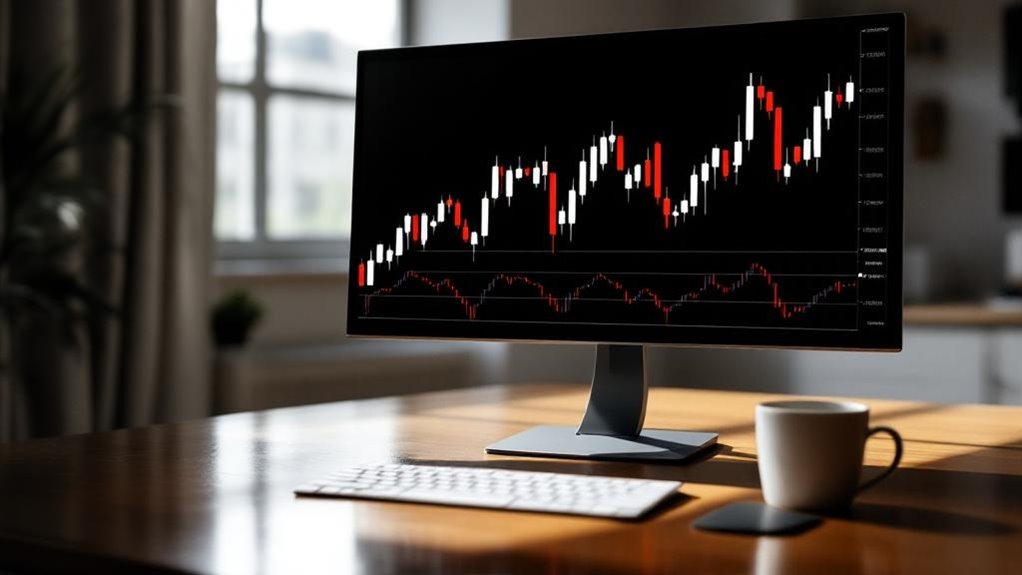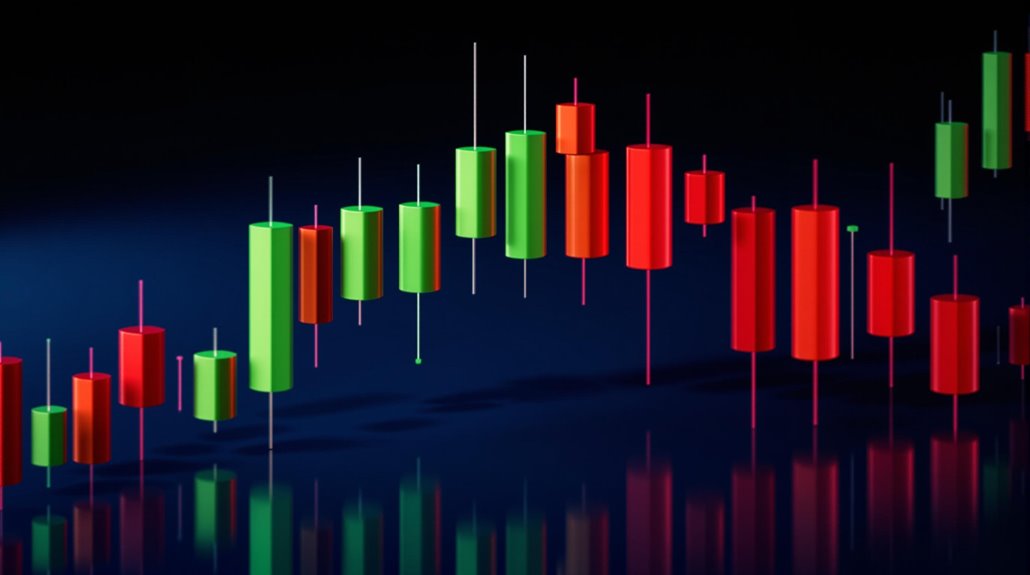Price action trading eliminates complex technical indicators in favor of analyzing raw price movements and chart patterns to reveal market psychology and behavior. This methodology emphasizes the study of candlestick formations, support and resistance levels, and market structures across multiple timeframes, while maintaining strict risk management protocols. Successful implementation requires extensive chart analysis, pattern recognition skills, and disciplined execution—fundamental components that form the foundation for mastering this pure market approach.
Key Takeaways
- Price action trading relies solely on raw price movements and chart patterns to reveal market psychology without complex technical indicators.
- Support and resistance zones form natural boundaries where price reversals frequently occur, making them crucial for trading decisions.
- Key candlestick patterns like pin bars, engulfing candles, and inside bars provide clear signals for potential market movements.
- Multiple timeframe analysis helps identify strong trading opportunities where patterns align across different time horizons.
- Trading success depends on disciplined execution, proper risk management, and extensive chart time for pattern recognition skill development.
The Core Philosophy Behind Price Action Trading

The essence of price action trading rests upon a foundational belief that market prices inherently contain all relevant information needed for trading decisions. This philosophy asserts that analyzing raw price movements provides the clearest window into market psychology and collective trading behavior.
At its core, price action methodology strips away complex technical indicators to focus exclusively on price and volume data. This minimalist approach emphasizes that all market factors – from fundamental analysis to news events – ultimately manifest in price movement. Successful implementation requires multiple timeframe analysis to develop a complete market perspective.
The discipline requires traders to develop acute observation skills and maintain strict trading discipline, responding to actual market movements rather than predicted outcomes. By eliminating the noise of lagging indicators, practitioners can focus on identifying key support and resistance levels, trend patterns, and momentum shifts in real-time. Traders commonly use candlestick chart patterns to interpret market sentiment and predict potential price movements.
This direct engagement with price data enables traders to adapt swiftly to changing market conditions while maintaining objectivity in their analysis and execution.
Essential Chart Patterns and Market Structures
Successful price action trading fundamentally relies on recognizing and interpreting key chart patterns and market structures that repeatedly emerge across different timeframes and asset classes.
These patterns serve as critical indicators of potential market movements and trend identification opportunities. Traders must confirm patterns by waiting one or two sessions to validate price movements. Understanding the psychological aspects behind pattern formation helps traders anticipate market participant behavior more effectively.
Primary chart patterns include:
- Ascending and descending triangles, with documented success rates of approximately 75%
- Cup and handle formations, signaling potential breakout opportunities
- Double-tops and rounding bottoms, indicating trend reversals
Market structures manifest in three primary forms:
- Uptrends characterized by higher highs and higher lows
- Downtrends exhibiting lower highs and lower lows
- Sideways consolidation phases between support and resistance levels
Traders leverage these patterns through:
- Strategic entry point identification at breakout levels
- Stop-loss placement based on pattern boundaries
- Profit target calculation using pattern height measurements
- Risk management protocols incorporating position sizing
Trading Without Indicators: A Pure Market Approach

Many experienced traders advocate for a stripped-down, indicator-free approach to market analysis that focuses exclusively on raw price action, allowing for unfiltered interpretation of supply and demand dynamics. This “naked trading” methodology emphasizes clarity and directness in price interpretation, eliminating the potential confusion caused by multiple technical indicators. By focusing on candle characteristics, traders can better anticipate market continuation patterns and make more informed trading decisions.
| Aspect | Traditional Trading | Pure Price Action |
|---|---|---|
| Analysis Tools | Multiple indicators | Price bars only |
| Decision Speed | Slower due to confirmation | Rapid price-based decisions |
| Learning Curve | Indicator mastery required | Direct market observation |
The effectiveness of trading without indicators stems from its ability to capture immediate market reactions and structural changes before they manifest in lagging technical studies. This approach demands rigorous discipline and extensive chart time to develop pattern recognition skills, but practitioners argue it yields superior insights into genuine market dynamics.
Mastering Support and Resistance Levels
As price action traders develop their analytical skills, mastering support and resistance levels becomes a foundational requirement for identifying high-probability trading opportunities in any market environment.
Support zones and resistance zones emerge through concentrated buying and selling activity, forming critical boundaries where price reversals frequently occur. Trading volume tends to surge near these levels, particularly around psychological barriers like round numbers, creating self-reinforcing reaction points in the market. Price action signals at these key levels can provide powerful confirmation for potential trade entries.
Multi timeframe analysis strengthens the identification of significant levels by revealing confluence across different time horizons. Moving averages can help validate these critical price levels and provide additional confirmation for trading decisions.
Traders implementing breakout strategies must remain vigilant of false breakouts, which often trap novice market participants before genuine price movements materialize.
Successful execution requires understanding how these levels transform their roles – former resistance becoming new support and vice versa – while maintaining strict risk management parameters when price approaches established boundaries.
This dynamic interplay between price action and market structure forms the cornerstone of technical analysis without indicators.
Building Your Price Action Trading Strategy

Building a robust price action trading strategy requires systematic integration of multiple analytical components while maintaining strict adherence to risk management principles. This foundational approach combines candlestick pattern recognition, trend analysis, and chart pattern utilization into a cohesive framework.
Successful implementation depends on identifying high-probability setups through confluence of multiple technical factors. Traders must recognize key patterns like pin bars, engulfing candles, and inside bars while validating these signals with corresponding volume analysis and market structure alignment. Understanding support and resistance levels provides critical reference points for determining optimal entry and exit positions. Monitoring volume breakouts can provide additional confirmation of price action signals and trend strength.
Trade psychology plays an essential role as practitioners must maintain disciplined execution without emotional interference. This necessitates consistent position sizing, predetermined stop-loss levels, and systematic profit-taking protocols.
The strategy’s effectiveness relies on continuous refinement through detailed trade journaling and performance analysis. Traders should document pattern reliability, success rates in varying market conditions, and adherence to established risk parameters to optimize their approach systematically.
Frequently Asked Questions
How Long Does It Typically Take to Become Proficient in Price Action Trading?
Achieving proficiency in market analysis typically requires 6-12 months of dedicated learning curve progression, though mastery often extends beyond 2 years.
Consistent practice sessions, comprising 2-3 hours daily of chart analysis and trade simulation, are essential for skill development.
While some traders may grasp basic concepts more rapidly, true competency demands extensive exposure to diverse market conditions and psychological development through sustained real-time trading experience.
What Is the Recommended Minimum Capital to Start Price Action Trading?
The recommended minimum capital allocation varies based on market type and trading strategy:
- Stock trading: $2,000-$3,000 for margin accounts, with $25,000 required for pattern day trading
- Forex trading: $500-$1,000 for standard accounts, though micro-accounts can start with $100
Risk management principles suggest starting with sufficient capital to:
- Maintain position sizes at 1-2% of total capital
- Withstand market volatility without margin calls
- Allow for proper trade diversification and position scaling
Can Price Action Trading Be Combined Effectively With Fundamental Analysis?
The synergistic fusion of price action trading and fundamental analysis creates an extraordinarily powerful analytical framework.
This integration enables traders to:
- Harness real-time market sentiment through price action while anchoring decisions in solid fundamental metrics
- Validate fundamental theses through price movement confirmation
- Execute more precise entries and exits by combining technical patterns with underlying value assessments
This thorough approach greatly enhances trading effectiveness when both methodologies align, offering sophisticated traders a robust edge in complex market environments.
Which Timeframes Work Best for Price Action Trading Strategies?
The ideal timeframe selection varies based on trading objectives and market conditions:
For short-term strategies:
- 15-minute and hourly charts provide precise entry points
- Perfect for day traders seeking multiple opportunities
- Requires active management and quick decision-making
For long-term strategies:
- Daily and weekly charts reveal sustained trends
- Better suited for position traders and swing traders
- Offers clearer support/resistance levels and reduced noise
- Allows for more thorough analysis of market structure
What Percentage of Successful Traders Rely Solely on Price Action Trading?
Like ancient traders who read tea leaves, modern market participants seek clarity through various methods.
While exact statistics on pure price action traders remain elusive due to the private nature of trading, industry observations suggest only a small minority (estimated at 10-15%) rely exclusively on price action.
Most successful traders integrate price action analysis with other tools, recognizing that market trends and trader psychology benefit from a more thorough approach to decision-making.
Conclusion
Mastering price action trading transcends the complexities of indicator-based analysis, offering traders a refined methodology to interpret raw market dynamics. While this approach demands rigorous discipline and pattern recognition capabilities, practitioners who immerse themselves in pure price action ultimately develop an invaluable skillset for maneuvering through market structures. As markets evolve, those who can read price movements with clarity and precision position themselves advantageously in the ever-shifting landscape of global finance.
References
- https://www.investopedia.com/terms/p/price-action.asp
- https://en.wikipedia.org/wiki/Price_action_trading
- https://priceaction.com/price-action-university/beginners/what-is-price-action/
- https://www.learntotradethemarket.com/price-action-trading-forex
- https://fxopen.com/blog/en/price-action-trading-key-concepts/
- https://www.investopedia.com/articles/active-trading/110714/introduction-price-action-trading-strategies.asp
- https://traderlion.com/technical-analysis/price-action-trading/
- https://optimusfutures.com/blog/price-action-trading-guide/
- https://blog.e8markets.com/articles/price-action-strategies-and-indicators
- https://tradethatswing.com/become-a-master-at-price-action-trading/

